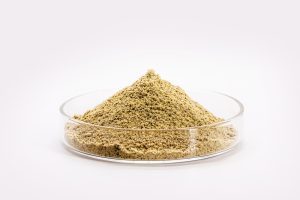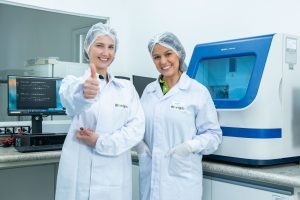Yeasts are single-cell microorganisms known and used by humans for over 5,000 years. The Egyptians used them to make bread and wine. They were recognized for their magical powers, and Louis Pasteur revealed part of their secrets. Today, yeasts are widely applied in animal nutrition as a source of proteins, peptides, free amino acids, nucleotides, B vitamins, and prebiotic and immunomodulatory compounds.
The food industry for human consumption uses yeast-derived products to improve and provide specific flavor characteristics to several types of foods. Yeast products derived from different processes, such as fermentation, extraction, and purification, may mimic specific flavors, such as beef or chicken, or allow the reduction of salt or sugar in foods without compromising their flavor. The latter are extremely important for the food industry.
When applying biotechnology to yeast processing, it is essential to consider several elements, such as the selected strain of the yeast Saccharomyces cerevisiae, its nutrition, and the fermentation environment. The entire production process needs to be controlled according to the established parameters. Those factors determine the functionality and the quality of the final product. The consistency of these factors will result in a product with a unique and standardized profile, meeting the quality and flavor standards required by the food industry.
In the pet food industry, yeasts are extensively used to improve food palatability. They can be included at different stages of the manufacturing process and are safe for animals of all ages. The flavor enhancement effect is attributed to the yeasts’ free amino acid profile, intensifying and extending the pleasant flavor felt in the mouth, providing umami flavor.
Using biotechnology processes, selected yeast strains are cultivated in favorable and controlled environments, following stringent food safety protocols, yielding natural and safe products that meet the increasing demands of the pet food market.
YEASTS IN PET NUTRITION
Whole inactive and dried yeasts derived from sugarcane or breweries are widely used as flavor enhancers by the dog and cat food industry. Such products can be added to the food mash before heat processing or by coating to increase food palatability and as a source of B vitamins.
Yeast products have also been used as alternatives to conventional protein sources to provide food amino acid balance and meet current market trends, such as plant-based, vegan, clean-label, and sustainability.
A study by Martins et al. (2013) demonstrated that dogs prefer foods containing whole and autolyzed yeast to foods with no yeast inclusion.
Autolyzed and hydrolyzed yeasts are derived from breakdown processes by endogenous and exogenous enzymes, respectively. Autolyzed and hydrolyzed yeasts have high protein digestibility, excellent B-vitamin profile, and high levels of free amino acids, increasing food palatability. They are also a source of nucleotides, essential components for cell renewal and various metabolic processes, contributing to animal health.
HiCell, Biorigin’s autolyzed yeast, improves the palatability of dog and cat foods due to its unique free amino acid profile. It should be noted that the functionality of such products depends entirely on the process each manufacturer applies.
THE USE OF YEAST-DERIVED PRODUCTS
Yeast products are essential in dog and cat food manufacturing. Yeast cell walls consist of an outer layer of mannan oligosaccharides, an inner layer of beta-1,3/1,6-glucans, and a small percentage of chitin.
Mannan oligosaccharides are considered prebiotics; they promote gut health because they are used as substrates by beneficial microorganisms in the gut. ActiveMOS, derived from the primary fermentation of Saccharomyces cerevisiae, is an outstanding example. Primary fermentation ensures high levels of cell wall compounds, enhancing product functionality. The mannan oligosaccharides in ActiveMOS act as substrates by gut microorganisms, which produce postbiotics, particularly butyrate. Moreover, ActiveMOS agglutinates non-beneficial bacteria, promoting a healthier intestinal environment.
Purified beta-glucans modulate the immune system and influence glucose and lipid metabolism. However, when not submitted to purification, those molecules remain protected by the mannan oligosaccharide layer and are unavailable to the animals. Consequently, they cannot act as immunomodulators because they cannot bind to the receptors of the gut immune cells.
In summary, yeast-derived products promote gut health and strengthen the immune system of dogs and cats, contributing to their well-being.
THE BENEFITS OF BIORIGIN’S MACROGARD
Biorigin’s MacroGard is recognized worldwide and has extensive scientific evidence of its effectiveness. The biotechnology applied to produce MacroGard provides it with high bioactive beta-1,3/1,6-glucan content while maintaining the original structure of the beta-glucan molecules, which is crucial for recognizing MacroGard by the gut immune system.
A recent study by Ferreira et al. (2022) with overweight and insulin-resistant dogs demonstrated another advantage of MacroGard. Three treatments were evaluated: obese dogs with insulin resistance (n=7, BCS=8 or 9), dogs with ideal body weight (n=7, BCS=5), and the same group of obese dogs after 90 days of MacroGard supplementation. The results showed that the insulin-resistant obese dogs fed MacroGard for 90 days had lower fasting glucose, cholesterol, and triglyceride levels. Furthermore, TNF-α levels were reduced, indicating lower inflammatory status associated with obesity, and GLP-1 levels, a hormone related to the feeling of satiety, were increased.
A notable feature of MacroGard is its heat stability, which means it can be easily incorporated in extruded and wet foods, as well as in snacks or capsules. This versatility makes MacroGard a convenient and effective option to improve the health and well-being of dogs and cats submitted to nutritional challenges.
Biorigin’s mission is to promote animal health and well-being, and this commitment is reflected in our constant investment in research and innovation to improve our solutions. If you want more information about Biorigin products or to contact one of our experts, we invite you to visit our website. We are ready to meet your needs and contribute to animal care and adequate nutrition.
References:
Martins et al. (2013). Brewer’s yeast and sugarcane yeast as protein sources for dogs. Journal of Animal Physiology and Animal Nutrition. DOI: 10.1111/jpn.12145
Ferreira et al., 2022. Metabolic variables of obese dogs with insulin resistance supplemented with yeast beta-glucan, BMC Veterinary Research, 2022, https://doi.org/10.1186/s12917-021-03106-2









